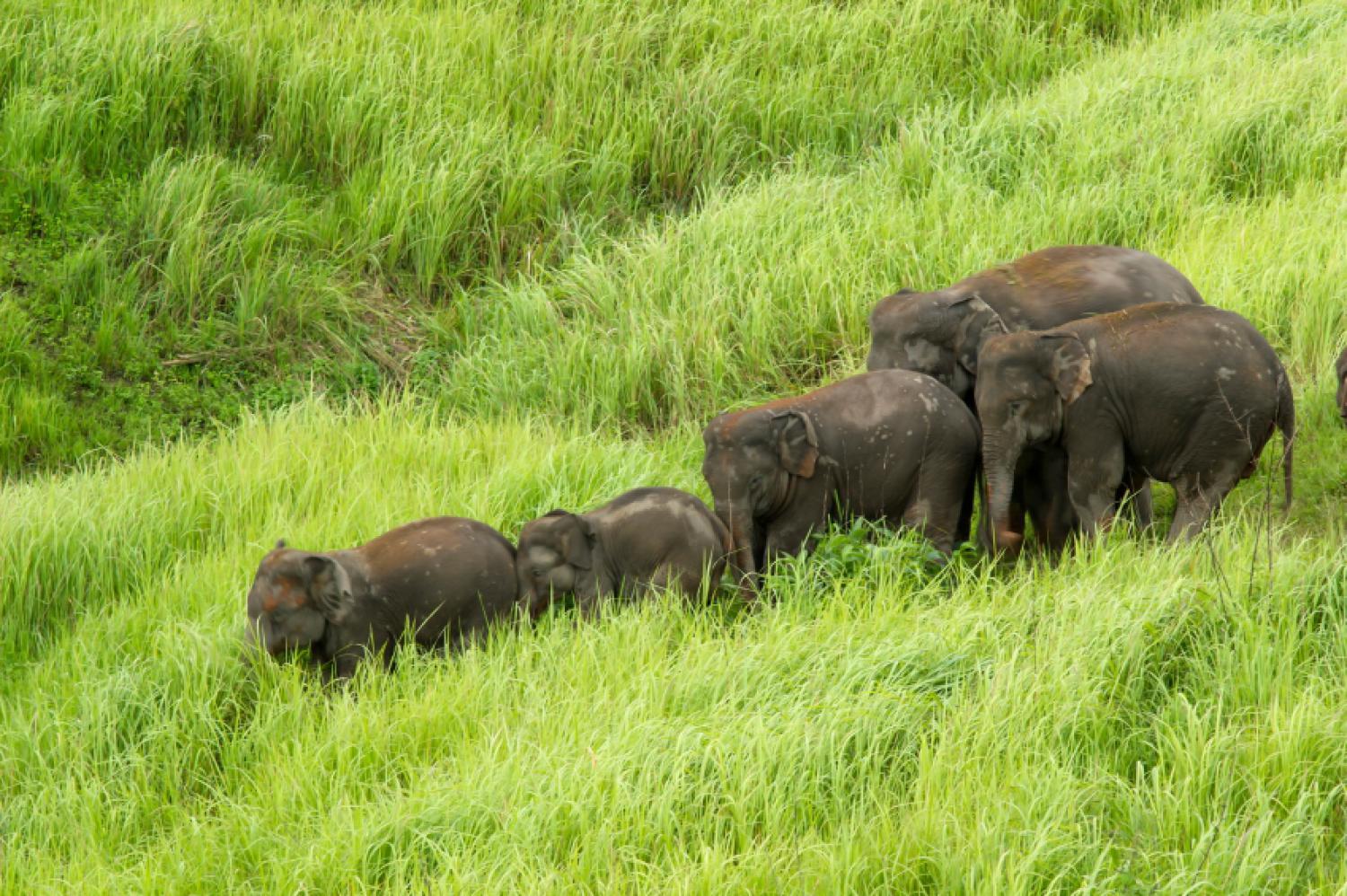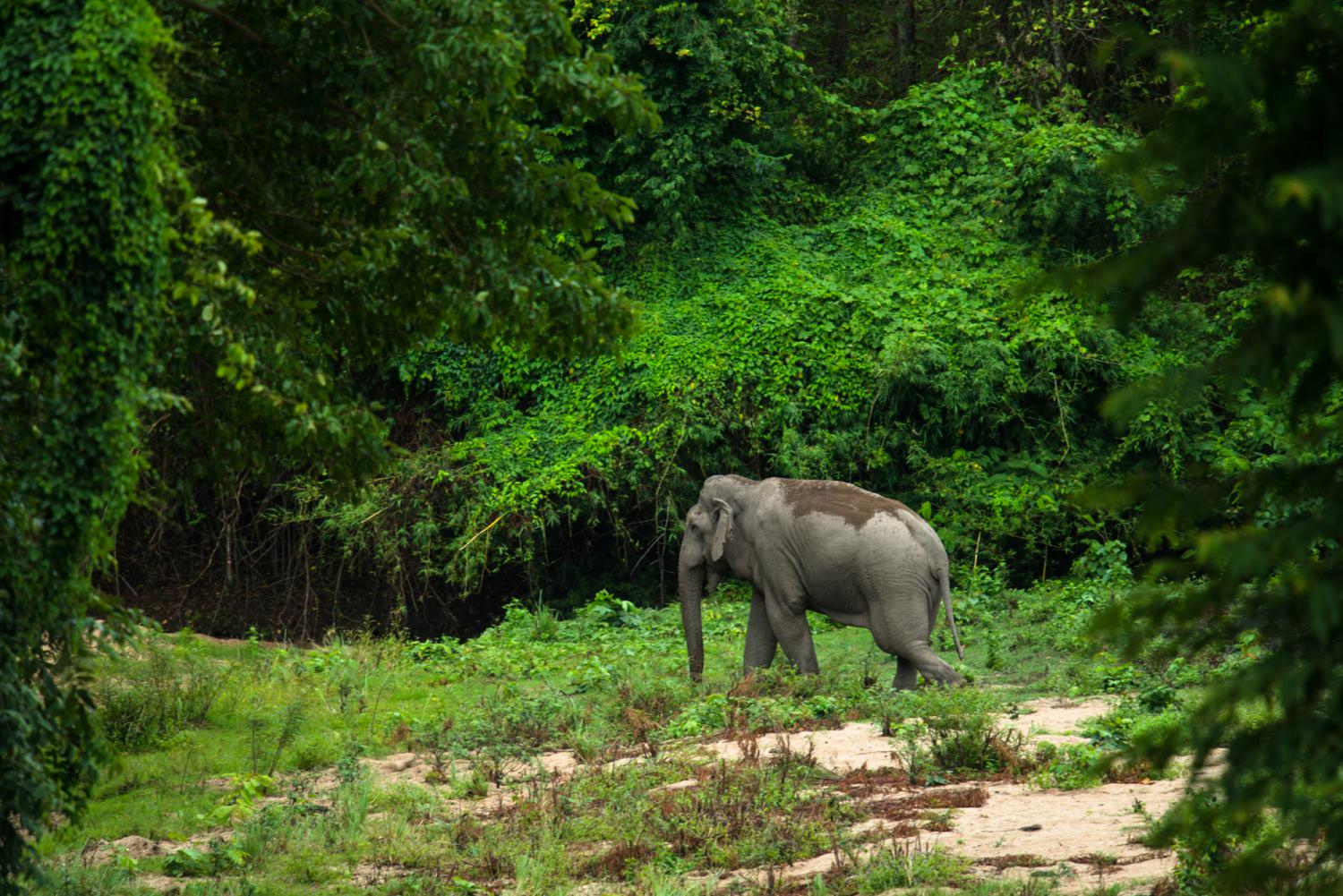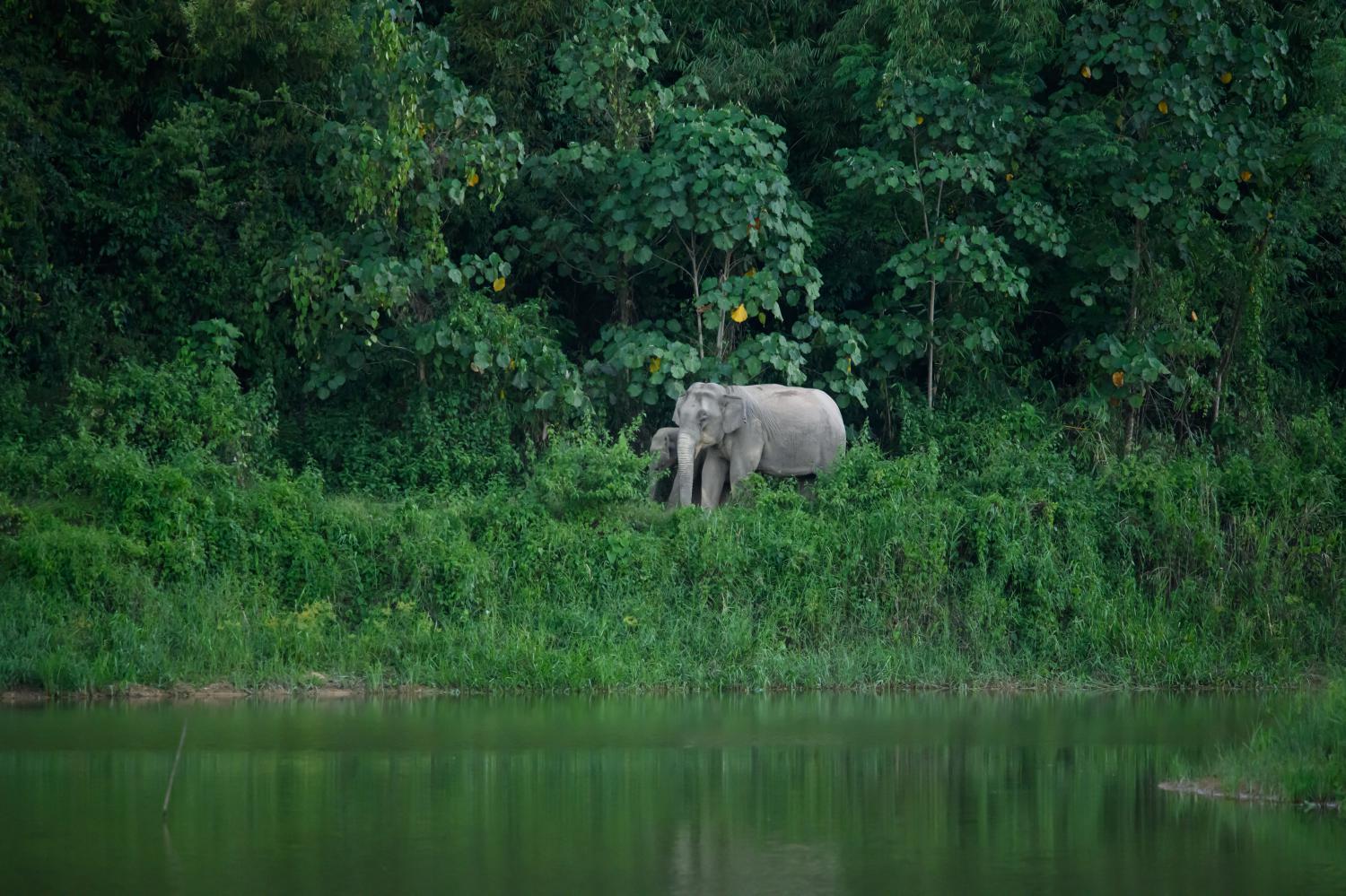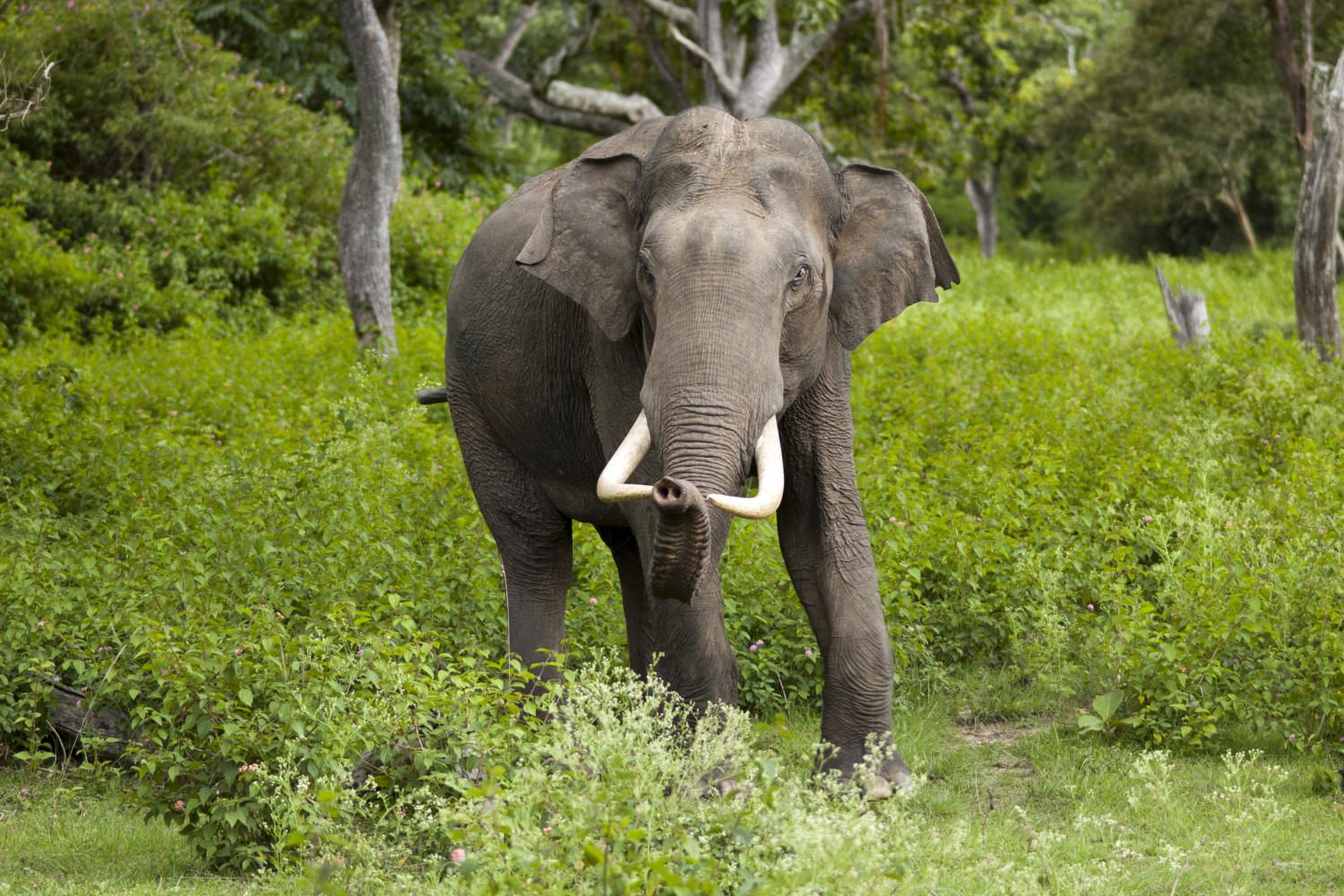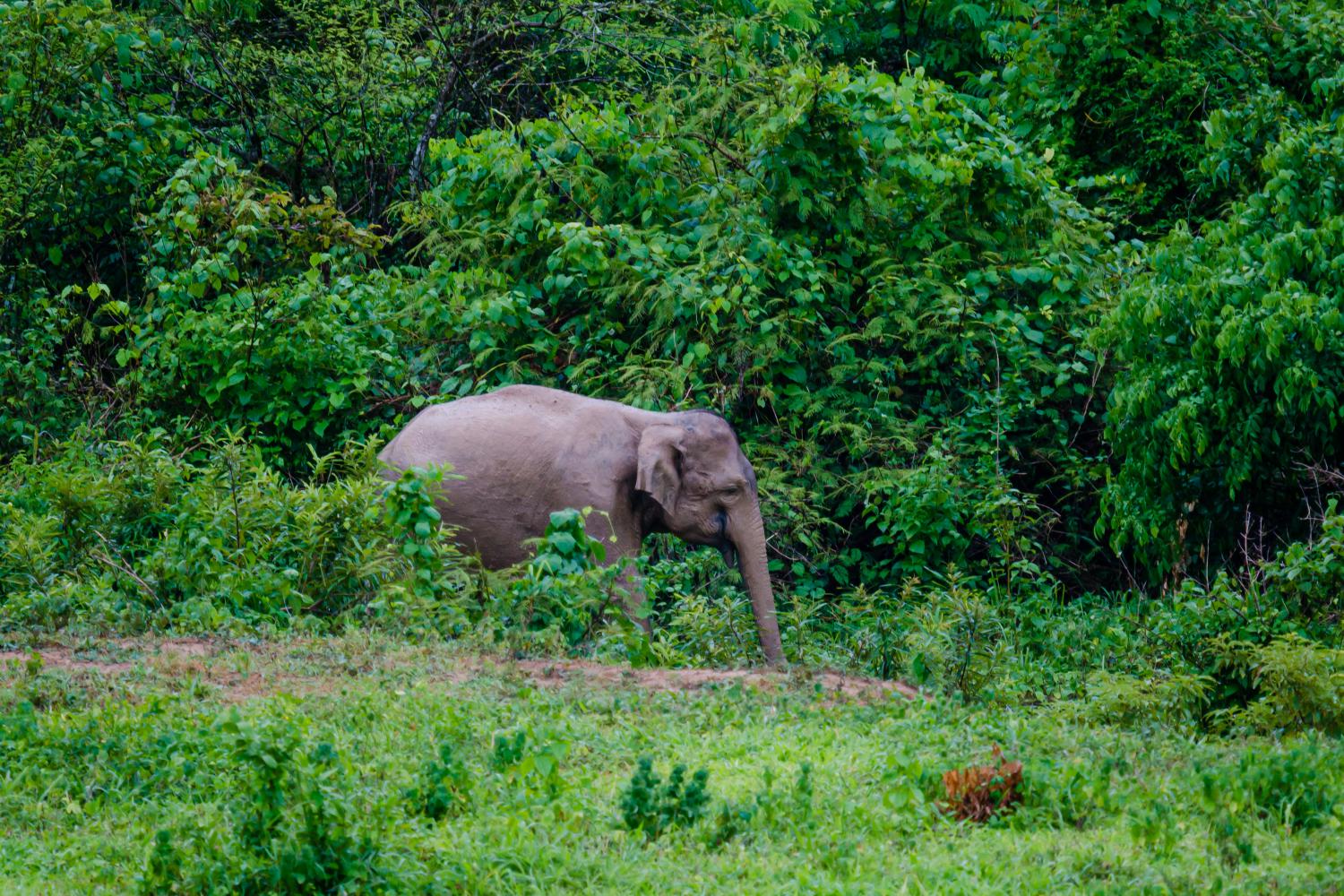Species of Thailand
Asian elephant
Elephas maximus, Carolus Linnaeus, 1758
(In Thai: ช้าง, chang)
The Asian elephant (Elephas maximus indicus) is one of three recognized subspecies of the Asian elephant and native to mainland Asia. Since 1986, Elephas maximus has been listed as Endangered by IUCN as the population has declined by at least 50% over the last 1 to -1 years or three generations. Asian elephants are threatened by habitat loss, degradation and fragmentation.
Characteristics
In general, Asian elephants are smaller than African elephants and have the highest body point on the head. The tip of their trunk has one finger-like process. Their back is convex or level. Indian elephants reach a shoulder height of between 2 and 3.5 m, weigh between 2000 and 5000 kg, and have 19 pairs of ribs. Their skin color is lighter than of maximus with smaller patches of depigmentation, but darker than of sumatranus. Females are usually smaller than males, and have short or no tusks.
The largest Indian elephant was 3.43 m high at the shoulder. In 1985, two large elephant bulls were spotted for the first time in Bardia National Park, and named Raja Gaj and Kanchha. They roamed the park area together and made occasional visits to the females. Raja Gaj stood 11.3 m tall at the shoulder and had a massive body weight. His appearance has been compared to that of a mammoth due to his high bi-domed shaped head. His forehead and domes were more prominent than in other Asian bull elephants.
Indian elephants have smaller ears, but relatively broader skulls and larger trunks than African elephants. Toes are large and broad. Unlike their African cousins, their abdomen is proportionate with their body weight but the African elephant has a large abdomen as compared to the skulls.
Distribution and habitat
Indian elephants are native to mainland Asia: India, Nepal, Bangladesh, Bhutan, Myanmar, Thailand, Malay Peninsular, Laos, China, Cambodia, and Vietnam. They inhabit grasslands, dry deciduous, moist deciduous, evergreen and semi-evergreen forests. In the early 1990s, their estimated population size was
- 26, 390–30, 770 in India, where populations are restricted to four general areas:
- in the Northwest — at the foot of the Himalayas in Uttarakhand and Uttar Pradesh, ranging from Katarniaghat Wildlife Sanctuary to the Yamuna River;
- in the Northeast – from the eastern border of Nepal in northern West Bengal through western Assam along the Himalaya foothills as far as the Mishmi Hills, extending into eastern Arunachal Pradesh, the plains of upper Assam, and the foothills of Nagaland, to the Garo Hills of Meghalaya through the Khasi Hills, to parts of the lower Brahmaputra plains and Karbi Plateau; isolated herds occur in Tripura, Mizoram, Manipur, and in the Barak Valley districts of Assam:
- in the central part — in Orissa, Jharkhand, and in the southern part of West Bengal, with some animals wandering into Chhattisgarh;
- in the South – eight populations are fragmented from each other in northern Karnataka, in the crestline of Karnataka–Western Ghats, in Bhadra–Malnad, in Brahmagiri–Nilgiris–Eastern Ghats, in Nilambur–Silent Valley–Coimbatore, in Anamalai–Parambikulam, in Periyar–Srivilliputhur, and one in Agasthyamalai;
- 100–125 in Nepal, where their range is restricted to a few protected areas in the Terai along the border with India. In 2002, estimates ranged from 106 to 172 resident and migratory elephants, with most of them in Bardia National Park;
- 150–250 in Bangladesh, where only isolated populations survive in the Chittagong Hills;
- 250–500 in Bhutan, where their range is limited to protected areas in the south along the border with India;
- 4, 000–5, 000 in Myanmar, where populations are highly fragmented, and occur in the northern and western hill ranges, in Pegu Yoma of central Myanmar, Tenasserim and Shan State;
- 2, 500–3, 200 in Thailand, mainly in the mountains along the border with Myanmar, with smaller fragmented populations occurring in the peninsula in the south;
- 2, 100–3, 100 in Malaysia;
- 500–1, 000 Laos, where they remain widely but patchily distributed in forested areas, both in the highlands and lowlands;
- 200–250 in China, where they survive only in the prefectures of Xishuangbanna, Simao, and Lincang of southern Yunnan;
- 250–600 in Cambodia, where they primarily inhabit the mountains of the south-west and in Mondulkiri and Ratanakiri Provinces;
- 70–150 in the southern parts of Vietnam.
Ecology and behaviour
Elephants are classified as megaherbivores and consume up to 150 kg of plant matter per day. They are generalist feeders, and both grazers and browsers. In a study area of 1130 km2 in southern India, elephants were recorded to feed on 112 different plant species, most commonly of the order Malvales, and the legume, palm, sedge and true grass families. They graze on the tall grasses, but the portion consumed varies with season. When the new flush appears in April, they remove the tender blades in small clumps. Later, when grasses are higher than 0.5 m, they uproot entire clumps, dust them skilfully and consume the fresh leave tops, but discard the roots. When grasses are mature in autumn, they clean and consume the succulent basal portions with the roots, and discard the fibrous blades. From the bamboos, they eat seedlings, culms and lateral shoots. During the dry season from January to April, they mainly browse on both leaves and twigs preferring the fresh foliage, and consume thorn bearing shoots of acacia species without any obvious discomfort. They feed on the bark of white thorn and other flowering plants, and consume the fruits of wood apple, tamarind, kumbhi and date palm.
In Nepal's Bardia National Park, elephants consume large amounts of the floodplain grass, particularly during the monsoon season. They browse more in the dry season with bark constituting a major part of their diet in the cool part of that season. During a study in a tropical moist mixed deciduous forested area of 160 km2 in Assam, elephants were observed to feed on about 20 species of grasses, plants and trees. Grasses such as Imperata cylindrica and Leersia hexandra constituted by far the most predominant component of their diet.
The movement and habitat utilisation patterns of an elephant population were studied in southern India during 1981–83 within a 1130 km2 study area. The vegetation types of this area encompasses dry thorn forest at 250 to 400 m, deciduous forest at 400 to 1400 m, stunted evergreen forest and grassland at 1400 to 1800 m. Five different elephant clans, each consisting of between 50 and 200 individuals had home ranges of between 105 km2 and 320 km2, which overlapped. They preferred habitat where water was available and food plants were palatable. During the dry months of January to April, they congregated at high densities of up to five individuals per km2 in river valleys where browse plants had a much higher protein content than the coarse tall grasses on hill slopes. With the onset of rains in May, they dispersed over a wider area at lower densities, largely into the tall grass forests, to feed on the fresh grasses, which then had a high protein value. During the second wet season from September to December, when the tall grasses became fibrous, they moved into lower elevation short grass open forests. The normal movement pattern could be upset during years of adverse environmental conditions. However, the movement pattern of elephants in this region has not basically changed for over a century, as inferred from descriptions recorded during the 19th century.
In the Nilgiri Biosphere Reserve three elephant clans had overall home ranges of 562 km2, 670 km2 and 799 km2 in the beginning of the 1990s. During three years of survey, their annual home ranges overlapped to a large extent with only minor shifts in the home ranges between years.
Threats
The pre-eminent threats to Asian elephants today are habitat loss, degradation, and fragmentation, which are driven by an expanding human population, and lead in turn to increasing conflicts between humans and elephants when elephants eat or trample crops. Loss of significant extents of elephant range and suitable habitat continues; their free movement is impeded by reservoirs, hydroelectric projects and associated canals, irrigation dams, numerous pockets of cultivation and plantations, highways, railway lines, mining and industrial development.
Elephant conservation in northern West Bengal has been set back due to high-levels of human–elephant conflict and elephant mortality owing to railway accidents. The railway track between Siliguri and Alipurduar passes through 74 km of various forest divisions. Every day, 20 trains run on this track at high speeds. Elephants that pass through from one forest patch to another dash against the trains and die. A total of 39 dead elephants were reported during the period of 1958 to 2008, of which ten were reported killed between 2004 to 2008.
In Bangladesh, forested areas that served as prime elephant habitat have undergone drastic reduction, which had a severe impact on the wild elephant population. Habitat loss and fragmentation is attributed to the increasing human population and its need for fuel wood and timber. Illegal timber extraction plays a significant role in deforestation and habitat degradation. As a result of the shrinking habitat, elephants have become more and more prone to coming into direct conflict with humans.
Poaching of elephants for ivory is a serious threat in some parts of Asia. Poaching of tuskers impacts on sex ratios that become highly female biased; genetic variation is reduced, and fecundity and recruitment may decline. Poaching has dramatically skewed adult sex ratios in the Periyar Tiger Reserve, where between 1969 and 1989 the adult male:female sex ratio changed from 1:6 to 1:122.
In Myanmar, demand for elephant ivory for making tourist items is higher than ever before. The military government shows little interest in reducing the ivory trade, while the elephants in the country have become the silent victims. After the world-wide ivory ban, prices of raw ivory in the country skyrocketed from $76 a kilo for large tusks in 1989/90 to over $200 a kilo by the mid-1990s. Foreign tourists are responsible for the massive rise in price of ivory tusks which fuels the illegal killing of elephants. There is also a sizeable trade in ivory chopsticks and carvings, smuggled by traders from Myanmar into China.
Some young wild-born elephants are removed from their mothers in Myanmar for use in Thailand's tourism industry. Mothers are often killed in the process, and calves are placed alongside unrelated cows to suggest they are with their mothers. The calves are often subjected to a 'breaking in' process, which may involve being tied up, confined, starved, beaten and tortured, as a result of which two-thirds may perish.
Elephant calves are vulnerable to predation.
This article uses material from Wikipedia released under the Creative Commons Attribution-Share-Alike Licence 3.0. Eventual photos shown in this page may or may not be from Wikipedia, please see the license details for photos in photo by-lines.
Scientific classification
- Kingdom
- Animalia
- Subkingdom
- Eumetazoa
- Phylum
- Chordata
- Subphylum
- Vertebrata
- Class
- Mammalia
- Subclass
- Theria
- Order
- Proboscidea
- Suborder
- Elephantiformes
- Family
- Elephantidae
- Subfamily
- Elephantinae
- Genus
- Elephas
- Species
- Elephas maximus
Common names
- English:
- Asian elephant
- Indian elephant
- Spanish: Elefante Asiático
- French:
- Eléphant D'Asie
- Eléphant D'Inde
- Thai:
- ช้าง, chang
- ช้างเอเชีย
Conservation status

Endangered (IUCN3.1)
Photos
Please help us review our species pages if wrong photos are used or any other details in the page is wrong. We can be reached via our contact us page.
Range Map

- Bang Lang National Park
- Chaloem Rattanakosin National Park
- Erawan National Park
- Huai Kha Khaeng Wildlife Sanctuary
- Kaeng Krachan National Park
- Kaeng Krung National Park
- Khao Ang Rue Nai Wildlife Sanctuary
- Khao Chamao - Khao Wong National Park
- Khao Khitchakut National Park
- Khao Laem National Park
- Khao Soi Dao Wildlife Sanctuary
- Khao Sok National Park
- Khao Yai National Park
- Khlong Lan National Park
- Khlong Nakha Wildlife Sanctuary
- Khlong Saeng Wildlife Sanctuary
- Khlong Yan Wildlife Sanctuary (s/e)
- Kui Buri National Park
- Nam Nao National Park
- Pang Sida National Park
- Phu Khiao Wildlife Sanctuary
- Phu Kradueng National Park
- Sai Yok National Park
- Salak Pra Wildlife Sanctuary
- Sipo Waterfall National Park
- Tat Mok National Park
- Thap Lan National Park
- Thong Pha Phum District, Kanchanaburi
- Thong Pha Phum National Park
